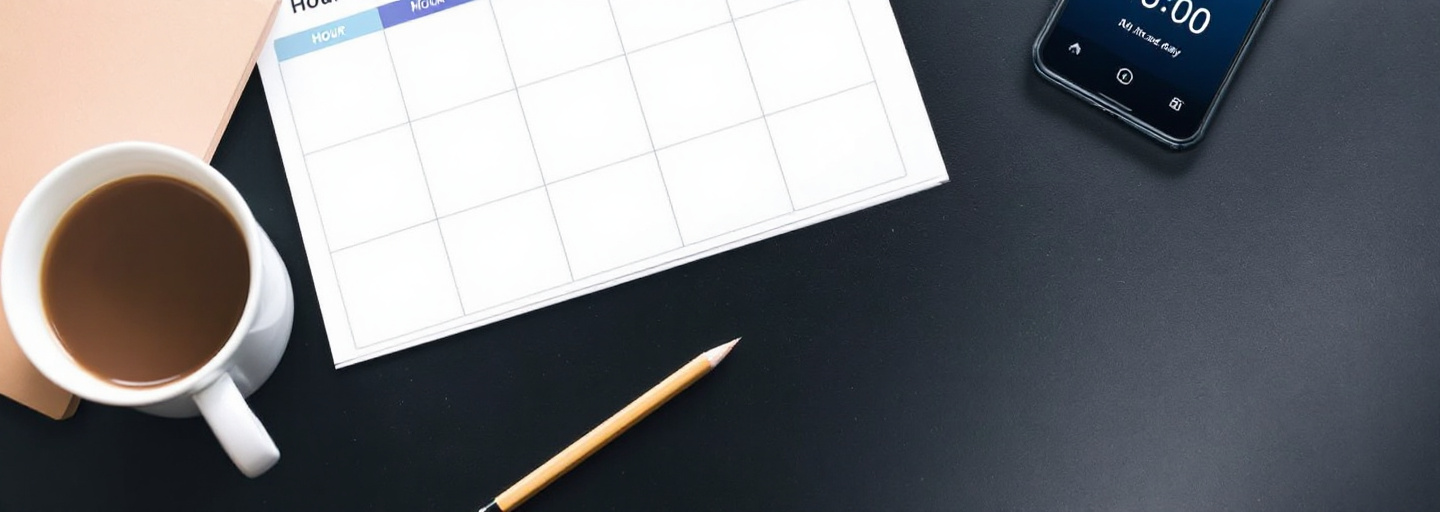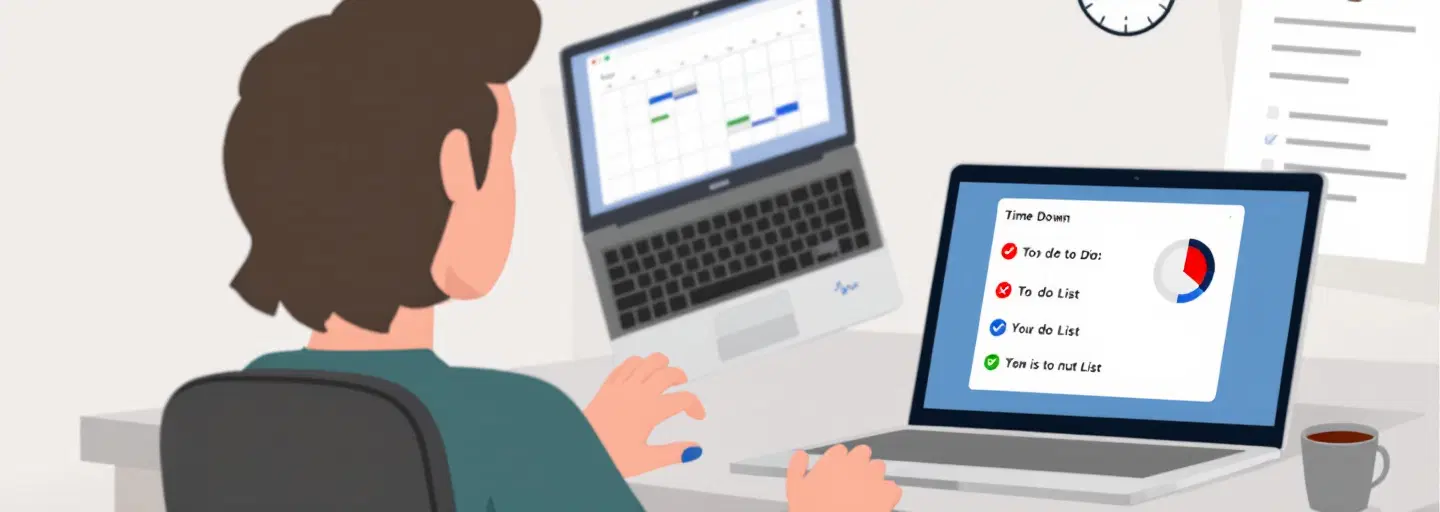Boost Daily Productivity with Smart Task Timing Strategies
« Back to all blog postsLearn how to boost your daily productivity using smart timing strategies like alarms, timers, and time blocks tailored to your energy levels.
The average worker loses nearly 2.1 hours daily to distractions and poor scheduling.
That’s a full workday each week vanishing into the productivity void.
While most productivity advice focuses on to-do lists and prioritization, the hidden factor that truly determines your output isn’t what you do but when you do it.
Why Timing Matters More Than You Think
Our brains aren’t designed for constant, uniform performance. Neuroscience research shows that our cognitive functions fluctuate throughout the day in predictable patterns called ultradian rhythms. These 90-120 minute cycles of peak performance are followed by natural dips in energy and focus.
When we work against these natural rhythms, we force our brains to use more glucose and oxygen than necessary, creating a physiological stress response. This explains why poor timing leads not just to reduced output but also to that familiar feeling of mental exhaustion despite having accomplished little.
Timing awareness creates a measurable reduction in cortisol levels. Studies from the University of California found that workers with clear temporal boundaries between tasks showed 23% lower stress hormones than those who worked in a more chaotic, reactive pattern.
The most fascinating aspect is how timing affects different types of thinking. Your analytical capabilities typically peak in the late morning, while creative insights often emerge during periods of lower alertness when the brain makes looser connections between ideas. This explains why your best problem-solving might happen at different times than your best creative work.
Understanding these patterns isn’t just about working harder. It’s about aligning your most demanding tasks with your brain’s natural high-performance windows, creating a workflow that requires less willpower and produces better results.
Break Your Day into Focused Time Blocks

Time blocking transforms vague intentions into concrete commitments by assigning specific activities to predetermined periods. Unlike traditional to-do lists that simply catalog tasks, time blocking forces you to make realistic decisions about what you can accomplish within the finite hours of your day.
How to Create Effective Time Blocks
Implementing a time blocking strategy requires more than just dividing your calendar into chunks. Follow these steps to create blocks that actually work:
- Identify your 2-3 most important tasks for the day before planning anything else
- Estimate realistic durations for each task (most people underestimate by 40%)
- Schedule your most important work during your personal peak performance hours
- Create 25-90 minute focused blocks with clear start and end times
- Add 10-15 minute buffers between blocks to prevent cascading delays
The key to successful time blocking is using clear signals for transitions between activities. Setting alarms to mark the beginning and end of each block removes the mental burden of clock-watching and helps your brain fully engage with the current task. Digital alarm tools can be particularly effective for maintaining this discipline without disrupting your focus.
Adjusting Blocks to Match Energy Levels
Not all hours of your day are equally valuable. Track your energy and focus for three days by rating yourself on a scale of 1-10 every hour. You’ll likely notice patterns emerging:
For high-energy periods (7-10), schedule tasks requiring deep analysis, important decisions, or creative problem-solving. These might include strategic planning, writing complex content, or tackling your most challenging project work.
During medium-energy periods (4-6), handle collaborative work, routine meetings, and administrative tasks that require attention but not peak creativity. This is also an excellent time for learning new information.
Reserve low-energy periods (1-3) for mechanical tasks like organizing files, responding to routine emails, or data entry. These activities can still move your work forward without demanding your best mental performance.
The beauty of this approach is its flexibility. Your time blocks become a framework, not a prison, allowing you to work with your natural rhythms rather than fighting against them.
Use Alarms to Reinforce Routine and Discipline
Alarms serve as external accountability tools that free your mind from the constant background task of time monitoring. Unlike calendar notifications that are easily ignored, alarm clock for routines create a physical interruption that demands acknowledgment.
Setting Up Habit-Building Alarms
The most powerful way to use alarms is through habit stacking, where you attach new behaviors to existing routines. Your brain forms stronger neural pathways when actions consistently follow specific triggers.
Key transition moments that benefit most from alarm reminders include:
- Morning routine kickoff (signals the shift from personal to work mode)
- Pre-lunch wrap-up (prompts you to consolidate morning progress)
- Post-lunch focus reset (helps overcome the afternoon energy dip)
- End-of-day review (triggers reflection and next-day planning)
- Digital sunset (signals when to stop screen time before bed)
When first establishing a new routine, set more frequent reminders, then gradually reduce them as habits form. This scaffolding approach provides support while your neural pathways strengthen, eventually allowing the behavior to become automatic.
Using Sound Cues Effectively
Different sounds create distinct psychological responses. Gentle, rising tones work best for transitions between activities, while sharper sounds are more effective for non-negotiable deadlines.
Match your alarm sounds to their purpose: use nature sounds for breaks, traditional bell tones for routine transitions, and more distinctive alerts for critical deadlines. This sound coding creates unconscious associations that strengthen your time boundaries.
Preset alarm features can simplify this process by allowing you to configure recurring reminders with appropriate sounds for each type of transition. The key is creating enough variety to prevent alarm fatigue while maintaining consistent associations between specific sounds and their intended actions.
Timers for Deep Work and Distraction Control

While alarms mark transitions between activities, timers create focus during active work periods. The visible countdown creates a psychological commitment to completing the current task, activating what psychologists call the Zeigarnik effect: our brain’s tendency to focus more intently on unfinished tasks when we’ve committed to a specific endpoint.
The Pomodoro Technique for Focused Work
The Pomodoro Technique’s 25-minute work intervals match our brain’s typical attention span before natural distractibility increases. This method works because it acknowledges our cognitive limitations rather than fighting against them.
However, the standard 25/5 minute work/break ratio isn’t optimal for everyone or every task. Consider these modifications based on your work type:
For creative work requiring flow states, try extended 50-minute sessions with 10-minute breaks. Complex problem-solving often benefits from longer immersion before interruption.
For administrative or repetitive tasks, shorter 15-minute sprints with 3-minute breaks help maintain engagement with less stimulating work.
When interruptions derail your timer, don’t restart the clock immediately. Instead, handle the interruption, then take a mini-break (2-3 minutes) before beginning a fresh interval. Specialized Pomodoro timers can help maintain this discipline by tracking your sessions and breaks automatically.
Creating Urgency with Countdown Timers
Parkinson’s Law observes that work expands to fill available time. Countdown timers combat this tendency by creating artificial constraints that focus your efforts.
| Task Type | Optimal Timer Setting | Break Length | Cycles Before Long Break |
|---|---|---|---|
| Email processing | 15 minutes | 3 minutes | 4 cycles |
| Writing/content creation | 50 minutes | 10 minutes | 2 cycles |
| Data analysis | 35 minutes | 7 minutes | 3 cycles |
| Meeting preparation | 20 minutes | 5 minutes | N/A |
For tasks where you’re unsure of appropriate timing, stopwatch tools can help establish baseline durations. Track how long activities actually take rather than how long you think they should take. This data becomes invaluable for future planning and reveals which tasks consistently consume more time than expected.
Plan Around Your Peak Productivity Hours
The best time to work isn’t universal. Your personal chronobiology creates unique windows of opportunity throughout your day that may differ significantly from your colleagues.
Identifying Your Personal Productivity Pattern
To discover your natural rhythm, track three key metrics for three consecutive days:
- Focus level: How easily can you concentrate without your mind wandering?
- Creative energy: How readily do new ideas and connections come to you?
- Physical energy: How alert and physically capable do you feel?
Rate each on a 1-10 scale hourly from waking until bedtime. Patterns typically emerge that align with one of three common chronotypes:
Morning larks experience their peak performance within 1-3 hours after waking, with a secondary peak in the late afternoon.
Night owls find their focus sharpening in the late afternoon and evening, often with creative insights emerging late at night.
Third-birds (or hummingbirds) experience their strongest performance in the middle of the day, with more consistent energy throughout rather than dramatic peaks and valleys.
Your pattern is also influenced by meal timing and caffeine consumption. Note when these occur to identify their impact on your energy fluctuations.
Scheduling Tasks to Match Your Rhythm
Once you’ve identified your pattern, reorganize your daily task types accordingly:
Schedule analytical work, important decisions, and learning new information during your peak focus hours. These tasks demand your best cognitive resources.
Place collaborative work, routine communications, and implementation tasks during your medium-energy periods. These activities benefit from social energy that can compensate for slightly lower focus.
Reserve administrative tasks, organization, and routine follow-ups for your lower-energy windows. These keep you productive without demanding peak performance.
When coordinating with team members across different time zones, time zone tools can help identify overlapping productive periods for scheduling collaborative work, ensuring everyone brings their best energy to shared projects.
Build in Breaks to Avoid Burnout
Breaks aren’t productivity killers. They’re productivity multipliers. Research from the University of Illinois found that brief diversions from tasks dramatically improve focus, while working without breaks leads to a phenomenon called “vigilance decrement” where performance steadily declines.
The Science of Effective Breaks
Our brains operate using directed attention, a limited resource that depletes with continuous use. This resource requires regular replenishment through specific types of breaks.
The optimal break frequency depends on your work type. For intense focus work, a 5-minute break every 25 minutes works best. For moderate-intensity tasks, 10-15 minutes every 75-90 minutes maintains performance. For low-intensity work, 30 minutes every 2-3 hours is typically sufficient.
The quality of your break matters more than its duration. Research shows that certain break activities replenish attention more effectively than others, with nature exposure being particularly powerful for cognitive restoration.
Active vs. Passive Break Strategies
Not all breaks are created equal. Their effectiveness depends on what they provide that your work doesn’t:
Physical movement breaks (walking, stretching, quick exercises) work best after periods of sedentary mental work. They increase blood flow to the brain and release tension from static postures.
Nature exposure breaks, even looking at images of natural settings for 40 seconds, significantly restore directed attention after focused screen work.
Social breaks provide emotional restoration after solitary work but can be depleting after periods of intense social interaction like back-to-back meetings.
Mindfulness breaks (brief meditation, deep breathing) help reset attention after scattered multitasking or high-stress work.
Try these quick 5-minute break activities with outsized recovery benefits:
- 4-7-8 breathing (inhale for 4, hold for 7, exhale for 8) repeated 5 times
- 20 jumping jacks followed by 10 slow stretches
- Gazing at distant objects outside a window (helps reduce eye strain)
- Writing three things you’ve accomplished so far today
- A brief progressive muscle relaxation sequence
For structured active breaks, circuit training timers can help maintain energizing routines without extending beyond your allocated break time, ensuring you get maximum benefit without disrupting your schedule.
Make Time Tracking a Daily Habit
The gap between how we think we spend our time and how we actually spend it is surprisingly large. Research shows most people overestimate productive time by 25% and underestimate distraction time by nearly 30%.
Simple Methods for Daily Time Audits
Effective time tracking doesn’t require complex systems. A simple end-of-day review taking less than 5 minutes can provide powerful insights:
Compare your planned time blocks with what actually happened. Note where you spent more or less time than expected, and identify any unplanned activities that emerged.
Beyond duration, track your energy level and satisfaction with outputs for each major task. This reveals which activities drain you disproportionately and which generate the most value relative to time invested.
The key is consistency rather than comprehensiveness. Tracking just your main activities daily provides more actionable insights than detailed tracking done sporadically.
Using Data to Refine Your Approach
After collecting a week of data, look for these patterns:
| Day | Task | Planned Duration | Actual Duration | Effectiveness (1-10) |
|---|---|---|---|---|
| Monday | Weekly planning | 30 min | 45 min | 8 |
| Tuesday | Project A development | 2 hours | 2.5 hours | 7 |
| Wednesday | Team meeting | 1 hour | 1.5 hours | 4 |
| Thursday | Email processing | 45 min | 1 hour | 6 |
| Friday | Weekly review | 30 min | 20 min | 9 |
Identify tasks that consistently take longer than planned and adjust your time blocking accordingly. This isn’t about working faster but about planning more realistically.
Look for low-effectiveness activities that consume significant time. These are prime candidates for delegation, automation, or elimination.
Notice which times of day consistently show higher effectiveness ratings and protect these windows for your most important work.
The goal isn’t perfection but progress. Each week, make one small adjustment based on your findings. These incremental improvements compound over time, gradually transforming your productivity without requiring unsustainable willpower or dramatic changes.
By implementing these daily productivity tips and refining them through consistent tracking, you’ll develop a personalized timing strategy that works with your natural rhythms rather than against them. The result isn’t just getting more done, but feeling better while doing it.
